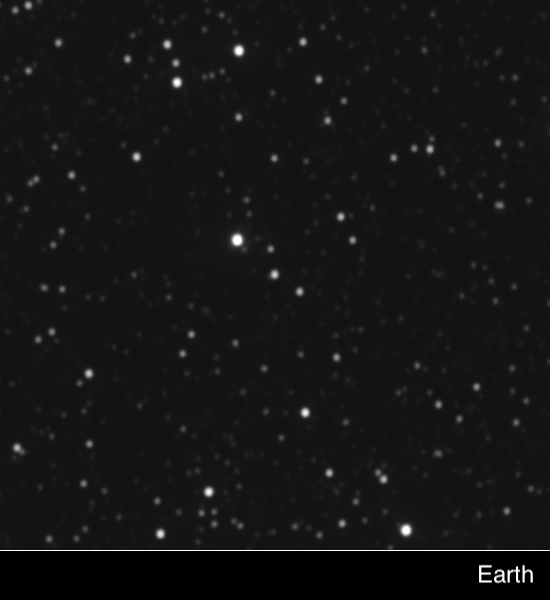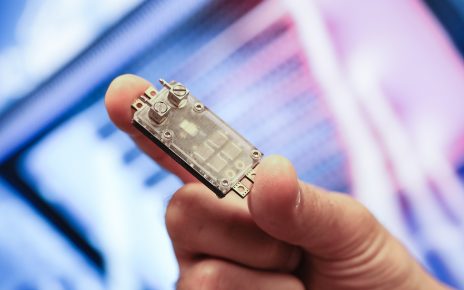NASA’s New Horizons probe wowed the world in 2015 with unprecedented pictures of Pluto, and, more recently, with the first close-up images of an object in the Kuiper belt of asteroids. Now the mission has achieved yet another first: measuring the distances of two stars from the outer reaches of the Solar System.
“It’s fair to say that New Horizons is looking at an alien sky, unlike what we see from Earth,” said Alan Stern, New Horizons principal investigator from Southwest Research Institute in Boulder, Colorado, in a statement released 11 June.
Most space telescopes, from the venerable Hubble Space Telescope to the brand new European planet hunter CHEOPS, stay in the vicinity of Earth: being outside the atmosphere is enough to provide a great view, and there is usually no reason to venture farther. But there are sometimes advantages to making observations from deep space.
On 22 and 23 April, the New Horizons team pointed the probe’s main camera at Proxima Centauri—the star closest to the Sun—which is about 1.3 parsecs (4.2 light years) away, as well as another star, called Wolf 359. NASA asked professional and amateur astronomers to take pictures of these two stars, at exactly the same time, from Earth. Because New Horizons is now 46 times farther from the Sun than Earth is, the two points of view are distant enough that the stars’ positions look slightly different with respect to other, more distant objects. By measuring that difference, astronomers can calculate the two stars’ distances from Earth.
This is a time-honoured technique, called parallax, and it is at the heart of the most sophisticated 3D maps of the Milky Way Galaxy, including the current state-of-the-art map, made by the European Space Agency’s Gaia probe. Parallax works on the same principle as binocular vision, which enables humans to roughly estimate the distance to an object by pointing both eyes on it.
But Gaia is stationed relatively close to Earth, and it calculates parallax by comparing its views of the same stars six months apart, either side of half an orbit around the Sun. Those two positions differ by merely twice the Sun–Earth distance—not 46 times, as in the case of the New Horizons probe. As a consequence, the parallax angles are tiny, and Gaia produces tables of numbers rather than something for people to look at.
“For all the impressive work Gaia does, you can’t see it,” says New Horizons team member Tod Lauer, an astronomer at the US National Optical-Infrared Astronomy Research Laboratory in Tucson, Arizona. “Here, you can see it—KaBlam!” The two shots of Proxima Centauri, one from the Kuiper belt and the other from Earth, show the star clearly shifting position. The images could become as iconic and memorable as the celebrated Pale Blue Dot, a picture of Earth taken by NASA’s Voyager 1 probe in 1990, Lauer says. The team has already been contacted by authors of astronomical textbooks who want to include the images in their next editions.
Watching from afar
Putting observatories into deep space—that is, anywhere beyond the Earth–Moon system—could offer a number of advantages. The best location for tracking potentially dangerous asteroids would be the inner Solar System, where objects that travel close to Earth—called NEOs, or near-Earth objects—would be seen against the darkness of space instead of the brightness of the Sun.
“With an orbit internal to the Earth’s, it is possible to have all NEOs outside the orbit,” says Paolo Tanga at the Côte d’Azur Observatory in Nice, France. “That way, all NEOs sooner or later end up in opposition to the Sun with respect to the observatory, which are the most favourable conditions for observations.” (BepiColombo, a double-probe mission currently on a seven-year journey to Mercury, was originally supposed to include a dedicated NEO telescope, but the plan was shelved to cut costs.)
Meanwhile, the Laser Interferometer Space Antenna (LISA), a trio of space probes that the European Space Agency plans to launch in 2034, will detect gravitational waves from a vantage point far from the disturbances of the Earth–Moon system. And, on occasion, it helps to do astronomy from the surface of Mars.
In the case of stellar-distance measurements, an observatory with Gaia’s sophistication could get much more precise parallaxes if it orbited far away. For example, at five times father from the Sun than Earth is—Jupiter’s distance—measurements would become five times more precise, at least in principle.
But astronomers have rarely considered sending probes into deep space. One reason is the time it would take for these instruments to gather good measurements. Gaia needs to orbit the Sun multiple times and to measure stars repeatedly to get a good parallax, and anything orbiting at Jovian distances would take much longer to do that, says Michael Perryman, an astronomer at University College Dublin who was among Gaia’s founding members. “Neglecting the energetic problems of getting a satellite there, and slowing it down, this would require a measurement duration of 3 to 5 orbits, or between 36 and 60 years,” says Perryman. “Enough said!”
Because New Horizons is combining its shots with images taken from Earth, it can get a parallax in one go, without having to wait. The probe was never designed to do astronomy, so its measurement of Proxima Centauri’s distance is orders of magnitude less precise than Gaia’s, Lauer says. But he adds that getting a better measurement was never the goal. The point was to demonstrate how far human ingenuity has come.
This article is reproduced with permission and was first published on June 11 2020.



